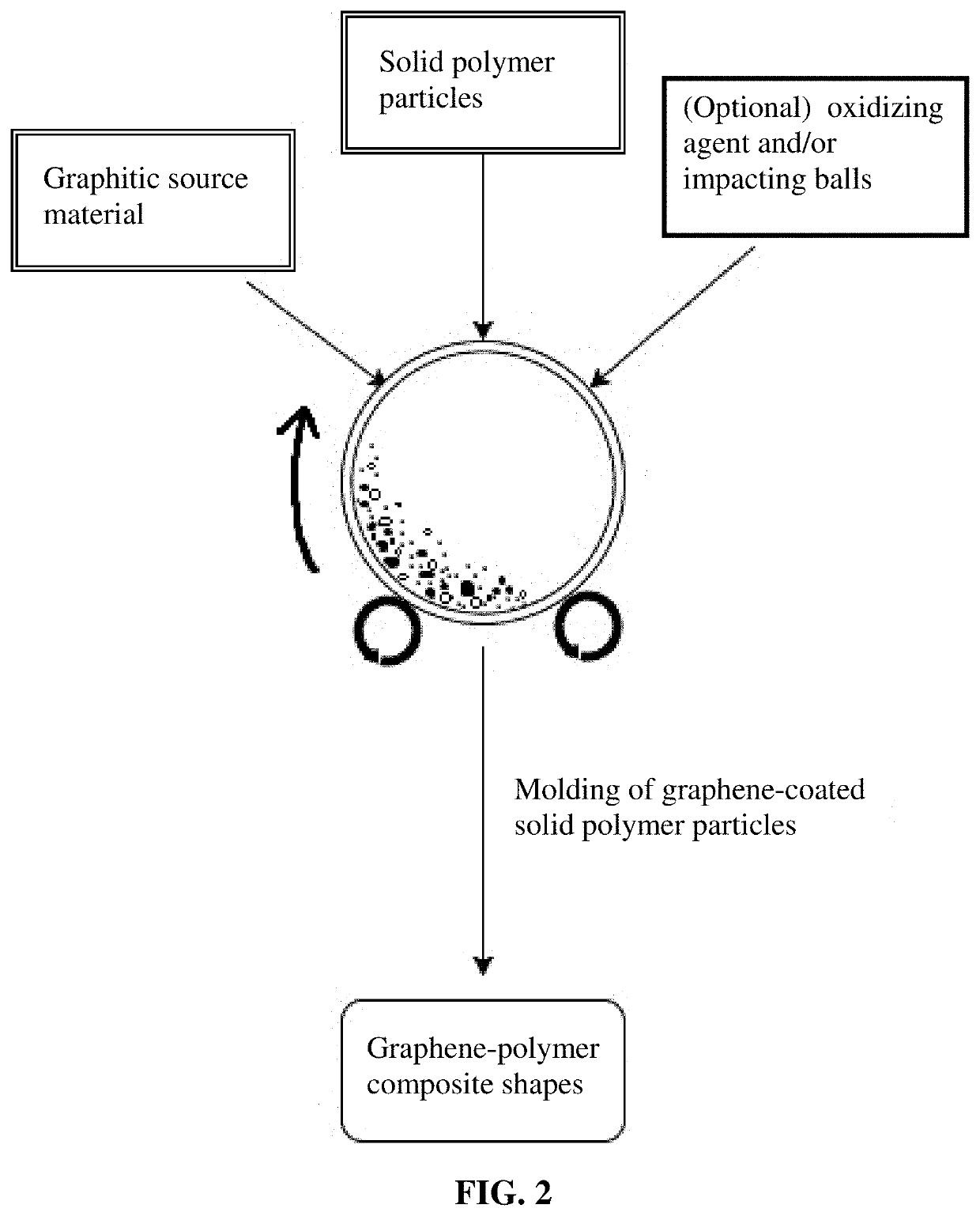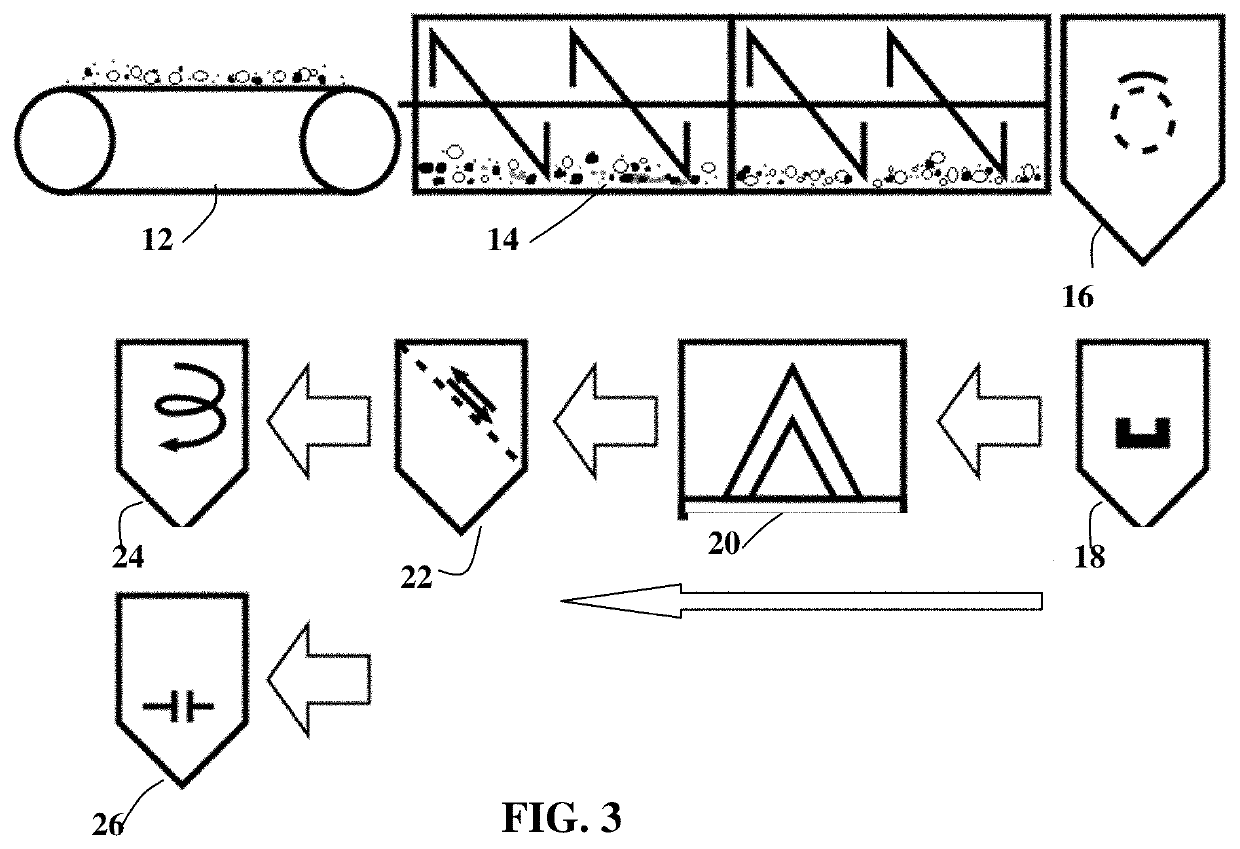Conducting polymer composite containing ultra-low loading of graphene
a graphene and composite material technology, applied in the field of graphene materials, can solve the problems of high energy consumption, high concentration of concentrated acid and oxidizer, and the tedious washing and purification step of heat- and solution-induced exfoliation approaches, and achieve the effect of increasing length and width
- Summary
- Abstract
- Description
- Claims
- Application Information
AI Technical Summary
Benefits of technology
Problems solved by technology
Method used
Image
Examples
example 1
raphene Composites from Flake Graphite and Polypropylene (PP), Polyethylene (PE), and Polyamide (Nylon 6 / 6) Powder
[0098]Powder samples of PE, PP, and Nylon from various sources were used as received or subjected to high-intensity ball milling to reduce particles to various sizes. Polymer-solvent liquid solutions were also subjected to atomization and spray-drying to obtain sub-micron and micron particles. These polymer particles were then subjected to ball milling to obtain graphene-coated polymer particles. In some cases, ZrO2 balls were used as the externally added impacting balls; hence, an indirect transfer process. In a typical procedure, 1 kg of polypropylene pellets and 50 grams of flake graphite (50 mesh, average particle size 0.18 mm provided by Asbury Carbons, Asbury N.J.) were placed in a ball mill-like rotational container or tumbler. The rotational container was operated at 30 rpm for 2 hours and 4 hours, respectively. The polymer particles were found to be coated with ...
example 2
Oxide from Expanded Graphite Via ABS Polymer
[0102]In an experiment, 100 grams of ABS pellets, as solid polymer particles, were placed in a 16 oz plastic container along with 5 grams of natural graphite. This container was placed in an acoustic mixing unit (Resodyn Acoustic mixer), and processed for 30 minutes. After processing, polymer particles were found to be coated with a thin layer of graphene.
[0103]Graphene-coated carrier particles were then immersed in a mixture of sulfuric acid and potassium permanganate (graphene / sulfuric acid / potassium permanganate ratio of 1.0 / 1.0 / 0.5) for oxidation of graphene to obtain GO sheet-coated ABS particles. The suspension was filtered using an appropriate filter and washed with distilled water. Subsequent to washing, filtrate was dried in a vacuum oven set at 60° C. for 2 hours.
[0104]It may be noted that the conventional Hummer's method typically requires the use of 24 mL (44 grams) of sulfuric acid and 5 grams of potassium permanganate to oxid...
example 3
lized Graphene from Mesocarbon Microbeads (MCMBs) Via Poly (Lactic Acid) or PLA
[0105]In one example, 100 grams of PLA pellets (carrier material), 2 grams of MCMBs (China Steel Chemical Co., Taiwan), and 2 grams of carboxylic acid (an oxidizing agent) were placed in a vibratory ball mill, which also contains particles of magnetic stainless steel impactor and processed for 1 hour to obtain graphene oxide-coated PLA particles. Subsequently, DETA was added and the material mixture was processed for an additional 1 hour. The vibratory mill was then opened and the carrier material was found to be coated with a brown-color coating of graphene oxide. The magnetic steel particles were removed with a magnet. The graphene oxide-coated polymer particles were rinsed with isopropyl alcohol and then water. The dried graphene-coated polymer particles were then molded into proper composite specimens for measurements of electrical and mechanical properties.
[0106]In separate experiments, the following...
PUM
| Property | Measurement | Unit |
|---|---|---|
| electrical conductivity | aaaaa | aaaaa |
| temperature electrical conductivity | aaaaa | aaaaa |
| temperature | aaaaa | aaaaa |
Abstract
Description
Claims
Application Information
 Login to View More
Login to View More - R&D
- Intellectual Property
- Life Sciences
- Materials
- Tech Scout
- Unparalleled Data Quality
- Higher Quality Content
- 60% Fewer Hallucinations
Browse by: Latest US Patents, China's latest patents, Technical Efficacy Thesaurus, Application Domain, Technology Topic, Popular Technical Reports.
© 2025 PatSnap. All rights reserved.Legal|Privacy policy|Modern Slavery Act Transparency Statement|Sitemap|About US| Contact US: help@patsnap.com



